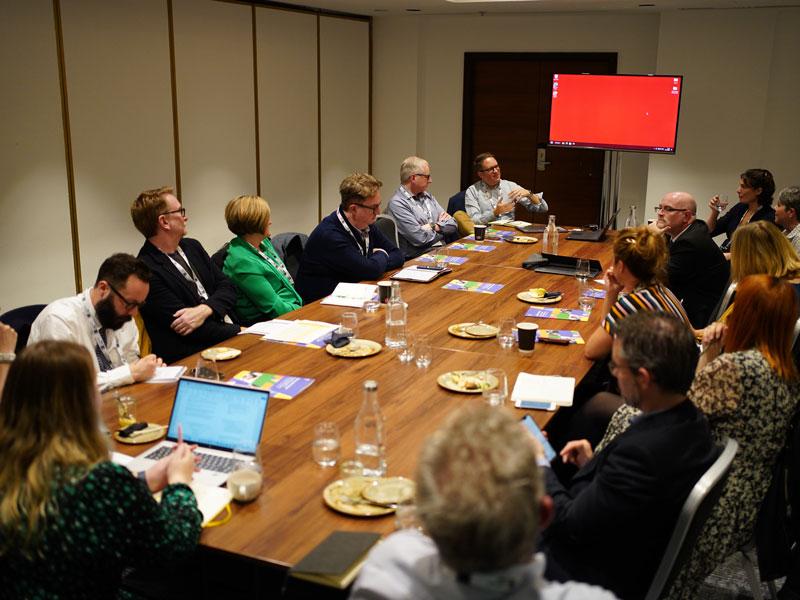
How US universities can future-proof skills education to boost graduate employability

Adobe
Learn how Adobe helps institutions incorporate digital tools into the curriculum
Offering microcredentials, “backward-designed” courses focused on skills, and embedding the latest technologies into curricula can help universities nurture job-ready graduates for the future workforce.
Experts from academia and industry joined a recent ����Vlog round table, held in partnership with Adobe, to discuss methods of adapting skills education to create more employable US college graduates.
Chair Alistair Lawrence, head of branded content at ����Vlog, said that as the digital transformation of the higher education sector continued, institutions needed to make experiential and project-based learning central to the student experience.
Todd Taylor, pedagogical evangelist at Adobe, said there was an international trend to “reorientate curricula and student learning outcomes and degree programmes around skills or capacities”. Teaching “open skills”, which are continually evolving, would help futureproof graduate learning outcomes against advancing technology.
“An example would be enabling our students to figure out how to collect and connect research in a narrative that communicates a call to action,” said Taylor. “This is what the Adobe Creative Campus programme is all about – having students move from being content consumers to becoming content producers.”
Bonnie Ferri, vice-provost for graduate and postdoctoral education and professor at the Georgia Institute of Technology, suggested that degree creation and curriculum design could be driven by the skills sought by employers.
“A lot of times when you create new master’s degrees or new degrees, you’re trying to cobble together some courses that you already have, and it’s driven by the faculty. But it really helps to have this backward design and say, ‘what is the industry looking for?’” Ferri said.
Sonia Feigenbaum, senior vice-provost for global engagement and chief international officer at the University of Texas, spoke about the university’s Essential Skills Immersion Series. The sessions focus on “the most in-demand skills for today’s job market and the future of work”, including budgeting and demystifying tech.
Demand for short courses, microcredentials and skills certificates continued to grow, said Thomas Cavanagh, vice-provost for digital learning at the University of Central Florida. “Things like our boot camps have been really successful. These are very practical workforce-oriented kinds of programmes and in many cases, students come in with degrees,” he said.
Roger Brindley, vice-provost of Global Penn State at Penn State University, said that the university was investigating ways to reach more learners, including international students, through offerings such as stackable degrees and multiple entries to programmes.
“I do worry, on the flip side of curricula integration, that curricula are held and cherished by the faculty because they see themselves as the stewards of that discipline, and quite rightly too,” Brindley said. “But that means it often is not nimble or agile to change.”
Pardis Mahdavi, provost and executive vice-president at the University of Montana, said universities had a responsibility to engage with the latest disruptive technologies, such as AI chatbot ChatGPT.
“We have an obligation as educators to start to teach students how to engage thoughtfully and critically with these technologies because that’s absolutely what students are going to need to be successful in the future,” Mahdavi said.
Michael Acedo, project manager at Stanford University, said the institution felt a responsibility “to really broaden the scope of what education can be to students, not only within our walls but outside of them as well”.
The university is working on ways to support high school students, including those from underserved communities, as they enter higher education. “Especially in fields that are going to lead them to potentially in-demand jobs,” Acedo said.
The panel:
- Michael Acedo, project manager, Stanford University
- Louna Al Hallak, chief academic officer, Stanton University
- Tonya Amankwatia, assistant vice-provost of distance education and extended learning, North Carolina Agricultural and Technical State University
- Roger Brindley, vice-provost, Global Penn State, Penn State University
- Thomas Cavanagh, vice-provost for digital learning, University of Central Florida
- Sonia Feigenbaum, senior vice-provost for global engagement and chief international officer, University of Texas
- Bonnie Ferri, vice-provost for graduate and postdoctoral education and professor, Georgia Institute of Technology
- Alistair Lawrence, head of branded content, ����Vlog (chair)
- Pardis Mahdavi, provost and executive vice-president, University of Montana
- Siela Maximova, director of strategy for Latin America and the Caribbean, Penn State Global, Penn State University
- Lauren Opgenorth, associate director of internship engagement, University of Southern California
- Todd Taylor, pedagogical evangelist, Adobe
Watch the round table on demand above or on the .
about Adobe’s solutions for higher education.
